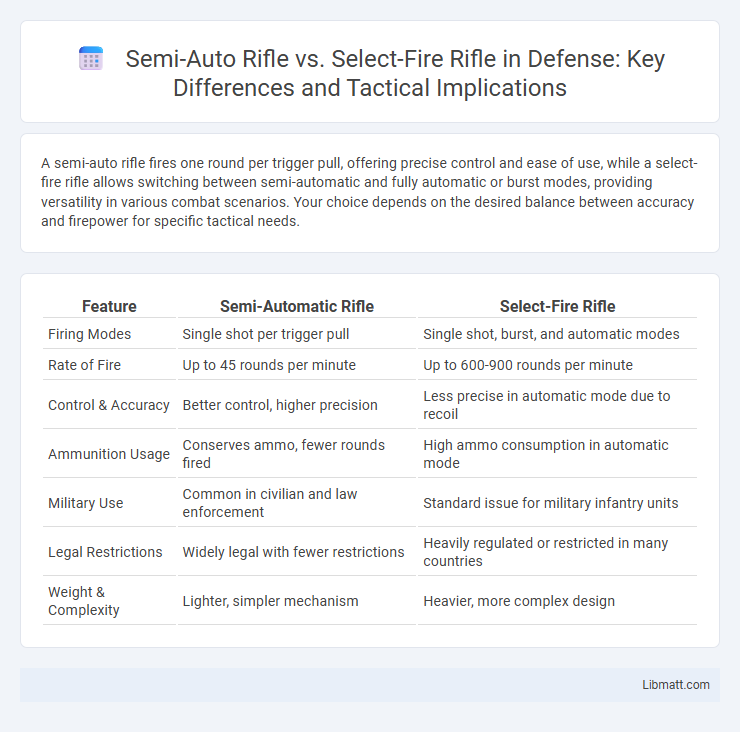A semi-auto rifle fires one round per trigger pull, offering precise control and ease of use, while a select-fire rifle allows switching between semi-automatic and fully automatic or burst modes, providing versatility in various combat scenarios. Your choice depends on the desired balance between accuracy and firepower for specific tactical needs.
Table of Comparison
| Feature | Semi-Automatic Rifle | Select-Fire Rifle |
|---|---|---|
| Firing Modes | Single shot per trigger pull | Single shot, burst, and automatic modes |
| Rate of Fire | Up to 45 rounds per minute | Up to 600-900 rounds per minute |
| Control & Accuracy | Better control, higher precision | Less precise in automatic mode due to recoil |
| Ammunition Usage | Conserves ammo, fewer rounds fired | High ammo consumption in automatic mode |
| Military Use | Common in civilian and law enforcement | Standard issue for military infantry units |
| Legal Restrictions | Widely legal with fewer restrictions | Heavily regulated or restricted in many countries |
| Weight & Complexity | Lighter, simpler mechanism | Heavier, more complex design |
Introduction to Semi-Auto and Select-Fire Rifles
Semi-auto rifles fire one round per trigger pull, automatically cycling the next round into the chamber without manual action, making them ideal for precision and control. Select-fire rifles offer multiple firing modes, typically semi-automatic and fully automatic, enabling rapid bursts or continuous fire for tactical versatility. Understanding these differences helps you choose the appropriate rifle for your shooting needs or tactical situations.
Defining Semi-Auto Rifles
Semi-auto rifles operate by firing one round per trigger pull, automatically chambering the next round without manual cycling. Unlike select-fire rifles, which offer burst or fully automatic modes, semi-auto rifles provide controlled, precise shooting ideal for hunting, sport shooting, and self-defense. Your choice of a semi-auto rifle emphasizes accuracy and legal compliance in jurisdictions restricting fully automatic weapons.
Understanding Select-Fire Rifles
Select-fire rifles offer multiple firing modes, including semi-automatic and fully automatic settings, providing versatility in various combat scenarios. Unlike semi-auto rifles that discharge one round per trigger pull, select-fire models allow continuous fire as long as the trigger is held, impacting accuracy and ammunition consumption. Your choice between the two should consider mission requirements, recoil management, and control during sustained firing sequences.
Key Mechanisms: How Semi-Auto and Select-Fire Differ
Semi-auto rifles operate by firing one round per trigger pull, utilizing gas or recoil energy to cycle the action and chamber the next round automatically. Select-fire rifles offer multiple firing modes, including semi-automatic, burst, and fully automatic, controlled by a selector switch that alters the firing mechanism's operation. Understanding these key mechanisms helps you choose between precise single shots and varied firing options for different tactical needs.
Historical Evolution of Rifle Actions
Semi-auto rifles evolved from early 20th-century designs emphasizing rapid fire without full automatic capability, enhancing marksmanship and ammunition conservation. Select-fire rifles emerged during World War II as versatile weapons allowing soldiers to switch between semi-automatic and fully automatic modes, adapting to multiple combat scenarios. Iconic models such as the M1 Garand for semi-auto and the M16 for select-fire illustrate this progression in military rifle innovation.
Tactical Applications: Semi-Auto vs Select-Fire
Semi-auto rifles provide precise, controlled shooting ideal for urban warfare and designated marksman roles due to reduced recoil and increased shot accuracy. Select-fire rifles offer versatility with modes for semi-automatic, burst, or fully automatic fire, making them suitable for suppressive fire and close-quarter combat. Tactical operations balance the need for accuracy and firepower by selecting the appropriate rifle based on mission parameters and engagement distance.
Legal Considerations and Restrictions
Legal considerations for semi-auto rifles often include ownership eligibility, magazine capacity limits, and restrictions on features such as pistol grips or folding stocks, varying significantly by jurisdiction. Select-fire rifles, capable of fully automatic or burst fire modes, are typically subject to stringent federal regulation, requiring special licensing, registration, and tax stamps under laws like the National Firearms Act in the United States. Compliance with both state and federal firearms regulations is essential for lawful possession and use of either firearm type.
Accuracy, Reliability, and Firepower Comparison
Semi-auto rifles offer greater accuracy compared to select-fire rifles due to reduced recoil and simpler firing mechanisms, allowing You to maintain precision with each shot. Reliability is often higher in semi-auto models since fewer moving parts and mechanical complexities reduce the chance of malfunctions during extended use. When comparing firepower, select-fire rifles provide versatile options with burst and fully automatic modes, delivering increased firepower but often sacrificing accuracy and reliability in demanding combat scenarios.
Civilian vs Military Use Cases
Semi-auto rifles, designed for civilian use, fire one round per trigger pull, making them suitable for hunting, sport shooting, and home defense due to their controlled rate of fire and compliance with firearm regulations. Select-fire rifles, favored by military forces, offer multiple firing modes including fully automatic and burst fire, providing enhanced tactical versatility and increased firepower in combat scenarios. Civilian restrictions on select-fire rifles stem from their potential for rapid fire, which is primarily intended for battlefield efficiency rather than civilian applications.
Choosing the Right Rifle for Your Needs
Semi-auto rifles fire one round per trigger pull, offering controlled, precise shots ideal for hunting and target shooting, while select-fire rifles provide multiple firing modes including burst and fully automatic, suited for tactical or self-defense scenarios. Understanding your specific requirements such as purpose, local laws, and handling proficiency helps determine which rifle aligns best with your needs. Prioritizing ease of use, accuracy, and legal compliance ensures your chosen firearm supports your shooting objectives effectively.
semi-auto rifle vs select-fire rifle Infographic

 libmatt.com
libmatt.com